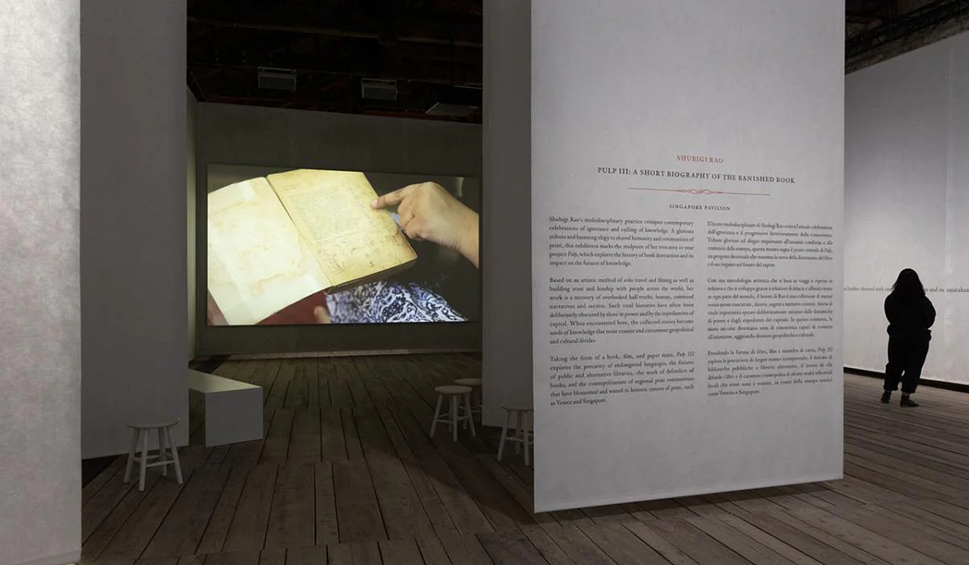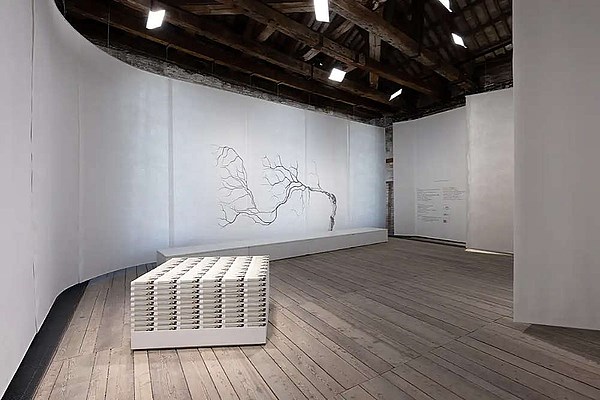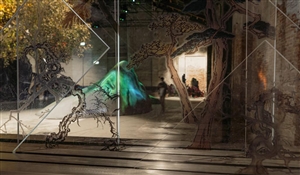In the Labyrinth of Papers; Singapore Pavilion at the Venice Biennale 2022
31 Aug 2022The 59th edition of the Venice Biennale, founded in 1984 and known by the title "Italian Art Exhibition Biennale," is currently running in Venice with the participation of artists from around the globe. Attending this art event since 2001, Singapore has selected works by one of its contemporary artists and writers to be displayed this year at the country's pavilion.

Inside the Singapore pavilion at Venice Biennale | PHOTO: ALESSANDRO BRASILE | Source: www.straitstimes.com
Shubigi Rao is a Singapore-based Indian artist whose interest in libraries, archive systems, history, literature and its related concepts, ecology, and natural history has led her to produce artworks focused on these fields. In her writings, films, and images, Rao observes current and historical turning points as perspectives for investigating the world's contemporary crises. She reviews people's viewpoints, languages, cultures, and institutions to achieve her final work.
The result of her last decade of activity, known by the title "Pulp III: A Short Biography of the Banished," refers in essence to the history of the destruction of books and the outlook on the future of information. In 2020, her second book of the same project won Singapore's literature award in the creative nonfiction category. The first volume was also mentioned in the final list of nominees in 2018. Both books have won several awards, such as the AIGA in New York and D&AD Pencil. Rao and architect Laura Miotto have jointly constructed a complicated installation with five thousand copies of Pulp Vol. III, arranged in the form of a film and a labyrinth of papers, explore issues, including the persistence of endangered languages, the future of public and alternative libraries, and the cosmopolitanism of regional communities that have blossomed and waned in historic centers of print and trade like Venice and Singapore. Additionally, the five thousand copies that will be handed over to the Venice Biennale visitors will eventually end up in small libraries across the world.

© Photo: Alessandro Brasile | Courtesy of Singapore Pavilion 2022 | Source : www.universes.art
Rao begins her explanation of the project with a question:
"What are our testimonies, and what is it we affirm? Are our certainties just circles of rationalising, restless half-truths, vivid imaginings and cynical manipulations? Or can we ask where the smallest form can speak to larger testaments?"
She continues:
"Every mark we read or see was made to bear witness to brief life and briefer designs. Every text then is a testimony, not necessarily of truth, but illuminating of time, idea, of the facts and falsities of place and moment. So, the stories in the Pulp project point to different forms of courage, in action, speech, in documenting and in sharing. These stories also make visible the nuanced forms of resistance in print, and of lives lived surrounded by books, of breathing air heavy with the weight of unread but priceless knowledge, of risking everything to save texts that are not theirs, and may never be read, but are also more than mere symbolic representations of their civilisations, or some idealistic notion of humanness."
One of the challenges Rao faced in this exhibition was that representing ten years of historical exploration was an impossible thing to do in the space provided by the Venice Biennale 2022. Nonetheless, she has tried to present the visitors with a unique spatial experience. Laura Miotto designed the structure of the Singapore pavilion in a way that helps the visitors gain a proper understanding of the interrelating space between writing and art without being over-immersed in it. Huge, simple, white curtains are installed all over the pavilion hall with only one line of the book's text printed on them. A video titled "Talking Leaves" is also being screened in some parts of the hall. The installation attempts to fulfill Rao's goal regarding the visitor's physical experience of the space.
The particular type of storytelling presented by the artist at this pavilion ends at this point. With the experience of such a space, the viewer will be encouraged to reflect on the influence of destroying books and libraries on human life.
Sources:
- www.artsy.net/article/artsy-editorial-10-best-national-pavilions-venice-biennale-2022
- www.labiennale.org/en/art/2022/singapore
- www.universes.art/en/venice-biennale/2022/pavilions-arsenale/singapore
- www.nac.gov.sg/singapore-arts-scene/art-forms/visual-arts/singapore-pavilion-at-venice-biennale/singapore-pavilion-2022
- www.biennialfoundation.org/2022/02/singapore-pavilion-at-the-venice-biennale-presents-shubigi-rao
Cover and slider image:
- www.adobomagazine.com






